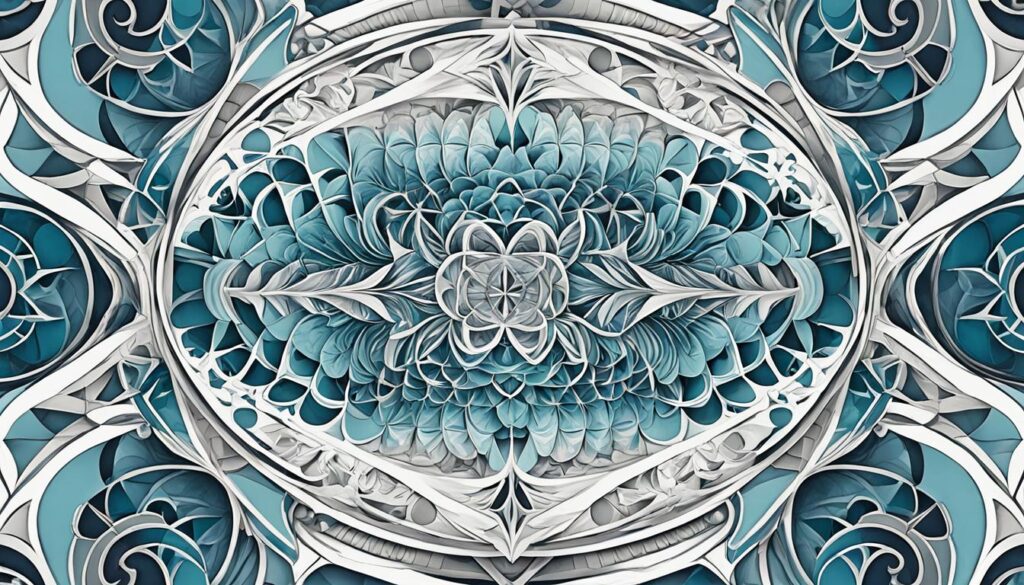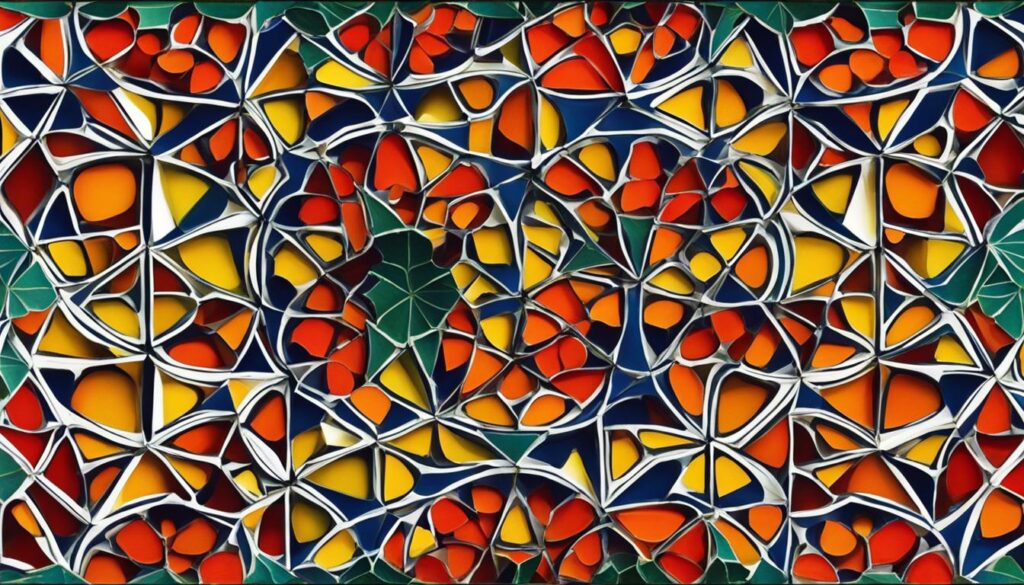Math and aesthetics are two seemingly disparate fields, yet the intersection of these disciplines is where beauty truly blossoms. Mathematical beauty is all around us, from the symmetry of a flower petal to the numerical elegance of a complex equation. In this article, we explore the relationship between math and aesthetics, delving into the aesthetic principles that underpin mathematics and the ways in which mathematical concepts contribute to our perception of beauty.
The exploration of math and aesthetics is not only intellectually stimulating but visually stunning as well. By uncovering the beauty in math, we enhance our appreciation of art and gain a newfound appreciation for both fields. Let’s dive in and discover the captivating relationship between Math and Aesthetics, exploring the mathematical beauty, aesthetic principles in mathematics, and beauty in math.
The Concept of Mathematical Beauty
In the realm of mathematics, the concept of beauty is not limited to the realm of aesthetics. Rather, it encompasses aesthetic principles that are grounded in numbers, symmetry, and elegance. Aesthetics in numbers refers to the visual appeal of mathematical expressions, showcasing the charm and distinction of the subject matter.
“Mathematics possesses not only truth but supreme beauty” – a famous quotation by Bertrand Russell elegantly sums up the interconnectivity between mathematics and aesthetics. One of the key contributors to mathematical beauty is symmetry – the balance, proportion, and harmony inherent in numerical patterns and expressions. The visual symmetry in mathematical concepts offers a gratifying aesthetic experience, one that transcends the mere function of the concept.
Aesthetic patterns in math also add an alluring dimension to mathematical beauty. The harmonious repetition of numbers or shapes in equations and geometric configurations not only beautifies the concept but also provides a framework for solving problems.
The elegance that arises from numerical relationships further enhances the aesthetic value of mathematics. The simplicity and efficiency with which a solution is obtained in mathematical equations or constructs evoke a sense of admiration and wonder.


The above image visually depicts the beauty of mathematical symmetry through patterns that are simple yet intricate. Just as these patterns are composed of various elements that blend seamlessly to create a cohesive whole, mathematical concepts too possess numerical elements such as symmetry and patterns that come together to form an elaborate, wonderfully complex entity.
Aesthetic Principles in Mathematics
Mathematics possesses a unique quality that goes beyond numbers and equations; it’s the way in which these constructs form a harmonious and aesthetically pleasing structure. Harmony in mathematics can be experienced when different components come together to create a unified whole. It is similar to the beauty that comes from musical harmony.
Mathematicians often strive for this harmony, as it signifies an underlying simplicity or elegance in the theory. Therefore, symmetry is a critical component of mathematical aesthetics. Symmetry is the visual manifestation of balance and harmony, and it is explored in multiple areas of mathematics.
The presence of aesthetic patterns in different mathematical domains has also captured the attention of mathematicians and artists alike. For instance, the Fibonacci sequence produces a recurring spiral pattern in nature and art, showcasing the power of numbers to create patterns that enchant the human eye.


“Mathematicians are not merely interested in these patterns and relationships as hidden entities, but rather delight in their aesthetic appeal, the elegance of the mathematics itself.” – Marcus du Sautoy
This aesthetic appeal inspires mathematicians to seek out new discoveries and push the boundaries of mathematical knowledge. The integration of beauty and mathematical theory expands the horizons of a discipline that is often seen as rigid, mechanical, and impersonal.
Beauty in Mathematical Symmetry
Mathematical symmetry is a critical element that contributes to the aesthetic appeal of mathematical principles. Symmetry is defined as the property of an object or system that remains invariant under specific transformations, such as translation, rotation, and reflection.
Symmetry can be found in different mathematical domains, including algebra, geometry, and calculus. One example of mathematical symmetry is the concept of periodicity, whereby a function or sequence repeats itself at regular intervals.


The visual appeal of mathematical symmetry is undeniable, as it creates a sense of balance, order, and beauty. Symmetry can also be used to solve mathematical problems and enhance our understanding of complex mathematical concepts.
In addition to symmetry, aesthetic patterns can also be found in various mathematical concepts. These patterns contribute to the visual appeal of mathematical principles, creating a sense of coherence and elegance.
“Symmetry is the language of nature and beauty. It is the foundation of art and science.”
The Significance of Symmetry in Enhancing our Aesthetic Experience
The aesthetic appeal of mathematical symmetry goes beyond its visual allure. Symmetry also plays a vital role in our perception of beauty in the world around us. The human brain is wired to recognize and appreciate symmetry, as it is a fundamental aspect of how we perceive objects and patterns.
Studies have shown that our brains respond positively to symmetrical objects, with these objects being perceived as more beautiful than asymmetrical objects. This connection between symmetry and beauty is not limited to mathematics but extends to other domains such as music, nature, and art.
| Example of Symmetry in Art | Example of Symmetry in Nature |
|---|---|
  |
The use of symmetry in art and nature can be used to create a sense of harmony and balance, leading to aesthetically pleasing compositions. In mathematics, symmetry plays a similar role, enhancing our experience of numerical elegance and creating a sense of visual beauty.
In conclusion, mathematical symmetry is an integral component of the aesthetic principles that underpin mathematics and our perception of beauty. By exploring the different types of symmetry found in mathematics and their significance in enhancing our aesthetic experience, we can gain a better understanding of the captivating relationship between math and aesthetics.
Conclusion
The intersection of Math and Aesthetics is a fascinating subject that continues to captivate us with its intriguing correlations. From the symmetry and numerical elegance that mathematical beauty offers to the aesthetic patterns that exist in various mathematical concepts, we have uncovered the many ways in which mathematics contributes to our sense of beauty in art.
The exploration of mathematical concepts is an exquisite journey that offers a playground for creative expression and intellectual exploration. By recognizing the enchanting synergy between math and aesthetics, we can enhance our appreciation of art while discovering the hidden beauty of complex mathematical structures.
In summary, Math and Aesthetics are two intertwined fields that complement each other profoundly. As we continue to explore the connection between them, we can appreciate the beauty of math and enhance our perception of aesthetics.
